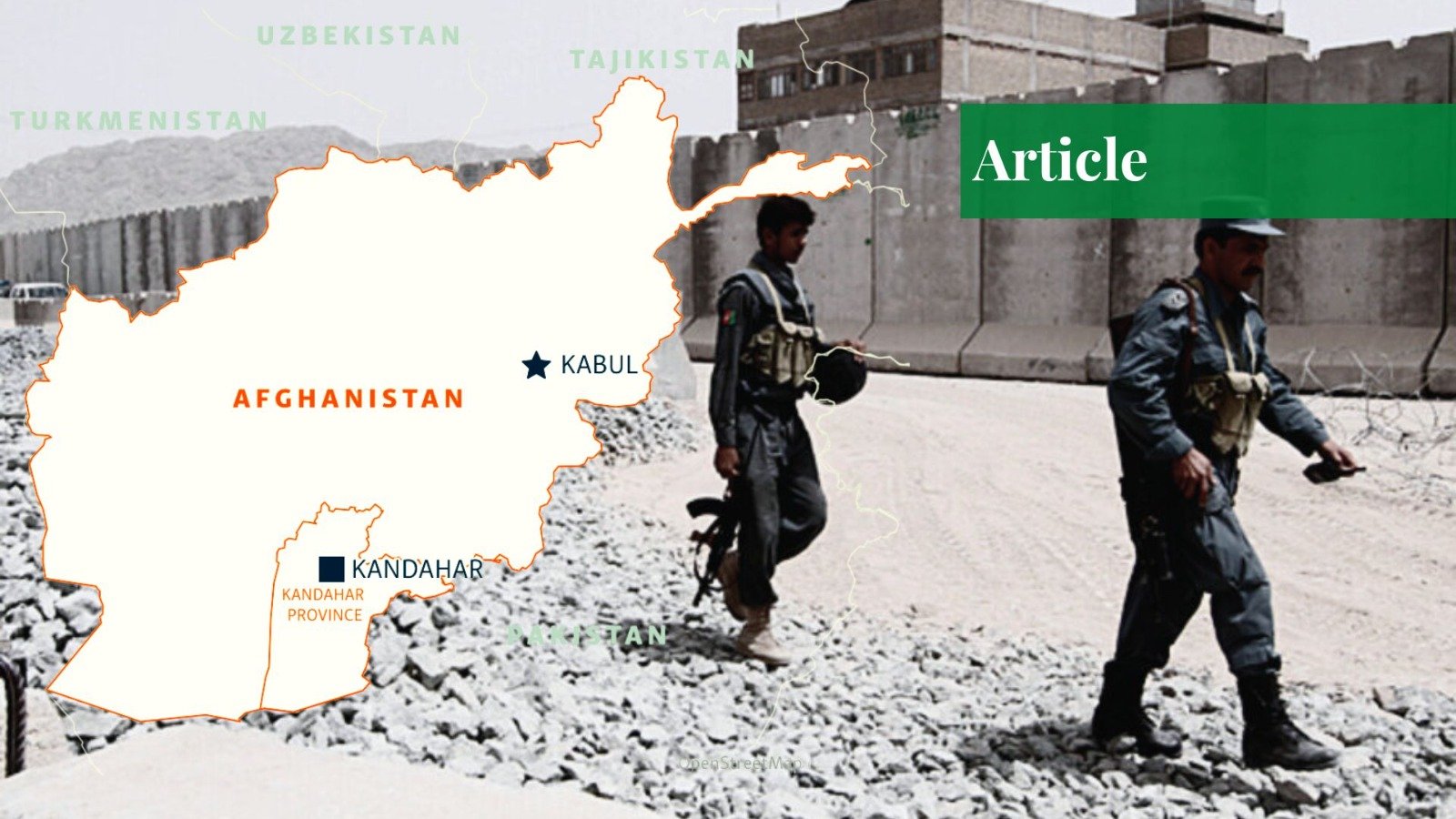Afghanistan is considered to be the most volatile part of South Asia. From historical events to contemporary affairs, Afghanistan has remained under pressure and chaos, both from outside and inside. The basic reason behind Afghanistan’s fragility throughout history is the hypocrisy of Afghan lords who had always backed out of their contracts and dealings. The external forces have always taken advantage of Afghanistan’s domestic instability and ethnic divide. As of now in Afghanistan, 42% are Pashtun, 27% Tajik, 9% Hazara, 9% Uzbek, 4% Aimak, 3% Turkmen, 2% Baloch, and 4% fall into an unspecified “other” group. All these factions are disorganized and dissatisfied with each other, where the security and influence of one group becomes the insecurity and fear of the other. Let’s analyze the internal divisions between different Afghan factions and their ripple effects.
The Power Centers: Kabul vs Kandahar
The centuries-old question of “who will control Afghanistan, Kabul, or Kandahar?” is still lingering there. The divide between Kabul and Kandahar is more than a geographic division. It’s more ideologically driven. Kabul from the start represents governance, statehood, diplomacy, and public representation. On the other hand, Kandahar is more tilted towards extreme nationalism, guerrilla warfare, religious conservatism, and radicalism. The Pashtun factions of both sides are in constant struggle with each other over political influence and superiority. This is the sole reason that the non-Pashtun residing in Afghanistan accept Kabul as the state’s power center. Thus, to date, Afghanistan is operating under the umbrella of this Kabul-Kandahar divide, resulting in domestic as well as external repercussions.
Historical Perspective
The historical split between Ghiljis and Durranis is of the most essential value in the context of the major division in Afghanistan, which has influenced the general political and social progress of the country. The Durrani confederation dated its origins to Ahmed Shah Abdali, the founder of the Durrani Empire in 1747. The Durrani empire comprised political institutions, strong administration, and an appropriate law and order system.
Moreover, Mirwais Hotak, a leader who seized the Loy Kandahar or Greater Kandahar and established the Hotak Empire in 1709, became the founder of the Hotak Dynasty and the modern-day Ghiljis. Ghiljis were more combatant rebels, extremists, and radical elements of the Afghan society. The consequence of this historical division was the formation of different fault lines in Afghanistan and ultimately the formation of the Afghan Taliban. So far, the Durranis control northern Afghanistan, and the Ghiljis the southern one.
Pashtun v/s Non-Pashtun Taliban
In addition to Pashtun tribal relations, Afghanistan is also divided by more profound ethnic divisions. The non-Pashtun communities, including Tajiks, Uzbeks, Hazaras, Turkmens, and Shias, have grievances with centralized governments controlled by Pashtun rulers. Most of these communities went through harsh periods of suppression, especially during the first term of the Taliban regime, which was generally perceived as ethnically biased toward Pashtun identity and antagonistic against Shia Hazaras.
However, the emergence of the Taliban in 2021 once again ignited the debate of equal political representation. The mainstream Afghan political leadership, including Mullah Hibatullah Akhunzada, Hasan Akhund, Abdul Gani Baradar, Mullah Yaqoob, Sirajuddin Haqqani, etc, are all ethnic Pashtuns. In February 2022, the Afghan Taliban arrested Makhdoom, an Uzbek military official, which resulted in widespread protests in Faryab province. Later on, due to public pressure, the Taliban released him and appointed him as the police chief of Ghazni province. Similarly, in March 2022, the Afghan Taliban removed Salahuddin, an Uzbek military official, from his position.
Similarly, the enmity between non-Pashtuns themselves is quite often used by the Taliban as a proxy for their influence. These differences are reflected in their ethnic narratives, aiming at uniting their ethnic kins across borders, such as the Pashtun aspiration for a unified Loy Pashtunistan, the Tajiks’ vision of the Khorasan-e-Bozorg and Anjuman Tajikan Jahan, and the Pan-Turkistan ideals of the Uzbek community. In Maidan Wardak, there are territorial disputes between Kuchis and Hazaras, where the former are ethnically Pashtuns and the latter are non-Pashtun Shias. The Taliban provide immense support to Kuchis in mass killings and confiscation of properties of Shia Hazaras.
Factionalism Within Afghan Leadership
The most prominent division in Taliban leadership is between Supreme Leader Hibatullah Akhunzada and Sirajuddin Haqqani, along with Mullah Yaqoob. Hibatullah holds extreme religious and social views. He strictly adheres to the ideological roots of theocracy and is against political inclusivity and educational reforms in Afghanistan. While Sirajuddin Haqqani and Mullah Yaqoob hold relatively moderate views in this regard, not because they have a liberal view, but due to the evolving regional and international dynamics. Having an upper hand and being the Supreme leader, Hibatullah has always denounced Sirajuddin Haqqani and his associates.
Sirajuddin Haqqani has long remained outside in UAE, which reflects his disagreement with the Taliban leadership. On the same note, Mullah Abdul Ghani Baradar, the longtime deputy of Mullah Omar, has had a series of in-and-out of the limelight and rumors of conflicts with the leaders of the Haqqani Network. Mohammad Abbas Stanikzai, an Afghan ambassador, has made an open statement against the Taliban’s prohibition of secondary and higher education for girls, claiming that the act was un-Islamic. This speech led to a travel ban, arrest threats, and eventual escape out of the country. In 2024, the brother of Jalaluddin Haqqani and Taliban Refugee Minister Khalil Haqqani was assassinated in a suicide bombing. Khalil’s killing further raised concerns of the Haqqanis against Hibatullah.
As of February 2025, former Taliban Justice Minister Abdul Hakim Sharia has resigned, exposing rampant corruption within the group, calling officials “thieves, traitors, and corrupt.” Moulvi Abdul Jabbar Hikmat, the Taliban’s commissioner at the Torkham border point, was also arrested for corruption in 2025. Former drug lord and long-term Taliban financier Haji Bashir Noorzai doesn’t hold any official position within the current Taliban government, calling into question his leverage. Equally, Taliban’s Chief Justice Abdul Baqi Haqqani is known to be extremely orthodox when it comes to girls’ education, and Sirajuddin Haqqani explicitly counters him on this. In addition, the current foreign minister of Afghanistan, Amir Muttaqi, is also keen to secure international recognition for his country, which goes against Hibatullah’s decrees.
Resistance Against Taliban
Currently, the National Resistance Front (NRF), headed by Ahmad Massoud, is giving the Taliban a tough time. The NRF has also collaborated with other new organizations. Urban guerrillas in Kabul and other cities have been involved in the Afghan Freedom Front (AFF), which was led by former security chief Dr. Yassin Zia. These operations are allegedly supported by intelligence networks that are in support of Amrullah Saleh and his Green Trend movement.
Similarly, the sentiments of anti-Taliban have also been experienced in Panjshir, Baghlan, Takhar, Badakhshan, and a section of Faryab and Sar-e-Pul due to ethnic resentment and opposition to the Taliban oppression. Various political figures are also resisting the Taliban. Amrullah Saleh positions himself as a legitimate defender of the republic; Yaseen Zia acts in the cells of resistance; Gulbaddin Hekmatyar possesses a moving political agenda, and he has always been able to negotiate with the Taliban but criticizes their excesses.
Growing Public Dissent
The ban on women’s education, inclusivity, and minority rights has created a serious dissent in Afghan locals with a desire to be well-connected and compete with the outside world. Poor economy, a high rate of unemployment, and a lack of basic amenities have undermined the legitimacy of the Taliban regime among the common citizens. Despite that mass demonstrations of the people are not common because of the fear of being repressed, the increasing dissatisfaction can be seen in the mere discussions. President Trump has blocked any form of economic aid, i.e., USAID, to Afghanistan as of 2025, which has further exacerbated the situation. The Taliban leaders have instructed the Afghan traders to discontinue trading with Pakistan and transfer to other routes due to the recent Pak-Afghan clash. This has elicited intense resistance and protests by the local traders against the Taliban.
Conclusion
The deep-rooted political, ethnic, and religious divide in Afghanistan has hampered its development and prevented it from playing a significant role as a stabilizer in the region. The extremists and moderate Taliban, as well as the Pashtun and non-Pashtun divide, have long created a situation of civil instability and chaos in Afghanistan. The local people are adversely affected by these political differences. Without the Taliban mending these fractures, Afghanistan will be stuck in the rut of power politics, and the war between Kabul and Kandahar will still be the hallmark of its future alignment.
If you want to submit your articles and/or research papers, please visit the Submissions page.
To stay updated with the latest jobs, CSS news, internships, scholarships, and current affairs articles, join our Community Forum!
The views and opinions expressed in this article/paper are the author’s own and do not necessarily reflect the editorial position of Paradigm Shift.
He is pursuing a BS in International Relations programme from International Islamic University, Islamabad and has a keen interest in research works, policy analysis, defence and strategic studies and conflict resolution.



